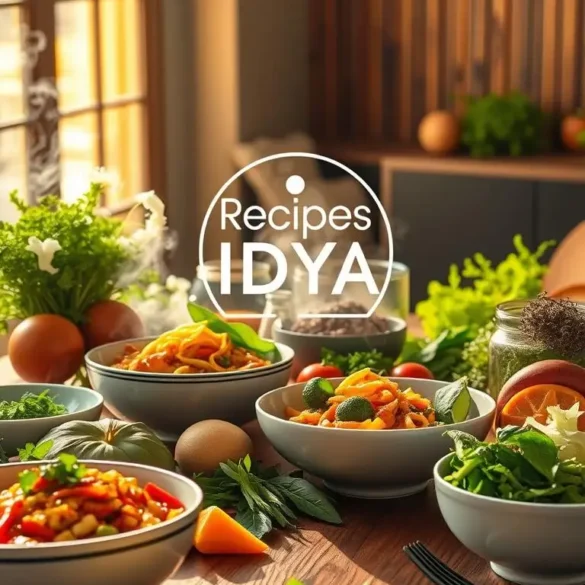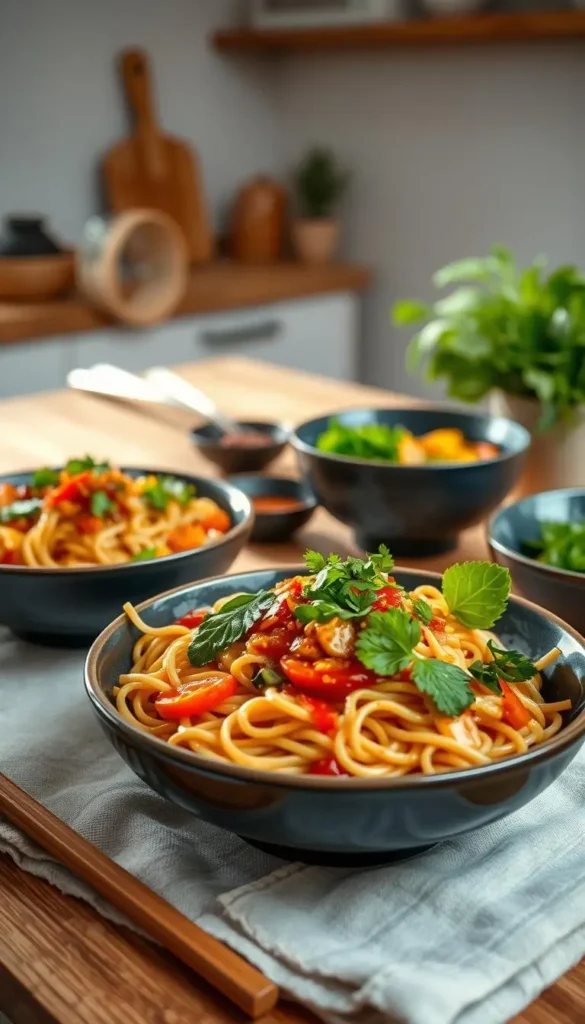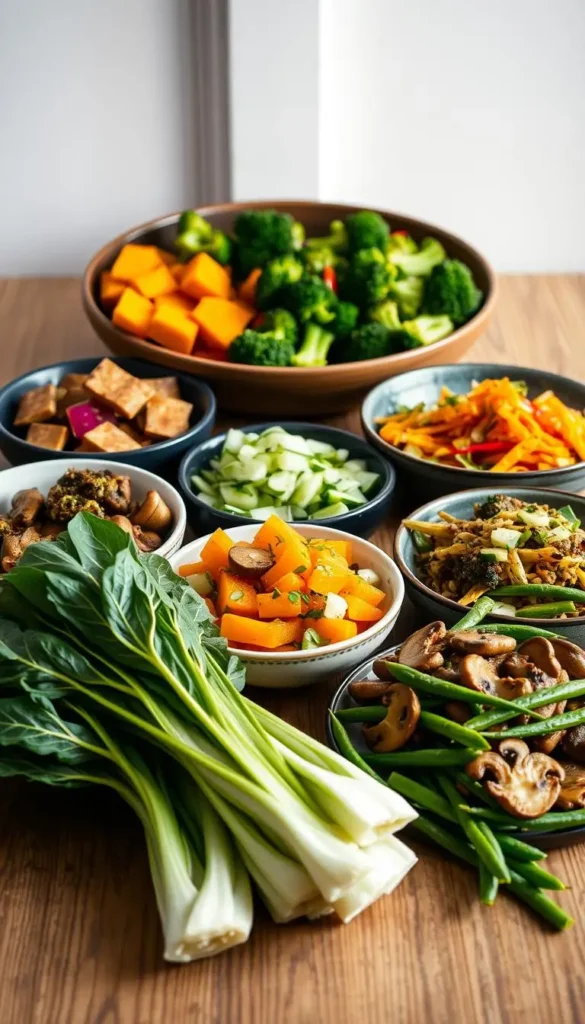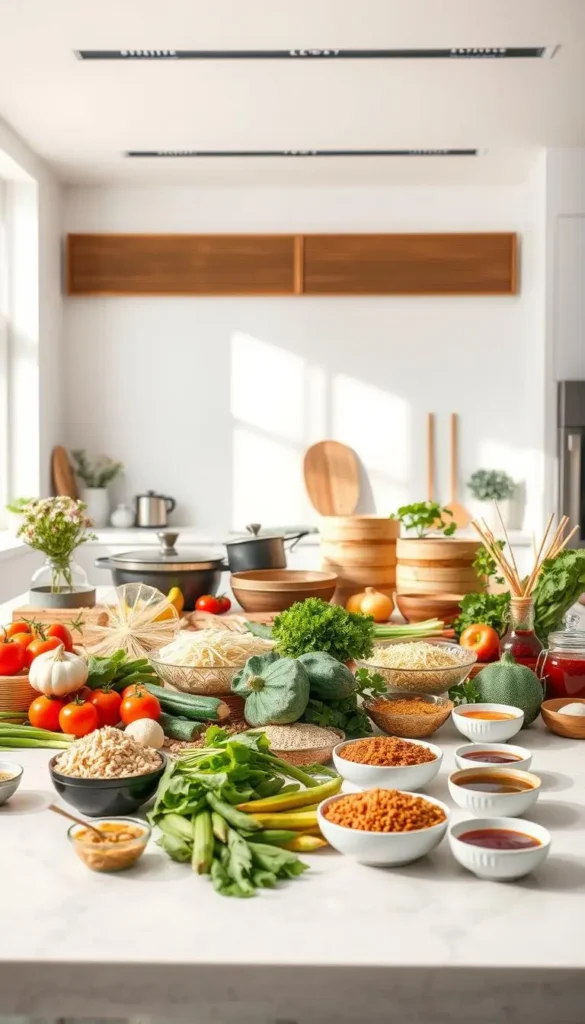
Ingredients
- 2 tablespoons olive oil
- 1 pound chicken breast, sliced
- 2 cups broccoli florets
- 1/2 cup sliced bell peppers
- 1/2 cup carrots, julienned
- 1 tablespoon soy sauce
- 1 tablespoon hoisin sauce
- 1 teaspoon ginger, minced
- 1 teaspoon garlic, minced
- 1 tablespoon sesame oil
- 1 teaspoon chili paste (optional)
- Salt and pepper to taste
Instructions
Heat olive oil in a large skillet or wok over medium-high heat. Add chicken breast slices and cook until browned and cooked through, about 5-7 minutes. Remove the chicken from the skillet and set aside. In the same skillet, add broccoli, bell peppers, and carrots. Stir-fry for about 3-4 minutes until vegetables are slightly tender. Add soy sauce, hoisin sauce, ginger, garlic, sesame oil, and chili paste (if using). Stir to coat the vegetables evenly. Return the cooked chicken to the skillet, toss everything together, and cook for an additional 2 minutes. Season with salt and pepper to taste before serving. Serve over brown rice or noodles for a complete meal.
Notes
You can substitute tofu for chicken for a vegetarian version of this dish. Adjust the chili paste amount to your preferred spice level.
Table of Contents
Are you ready to turn your kitchen into a vibrant place? Healthy Asian recipes offer a journey of flavor and nutrition. They take you beyond traditional Western cooking.
Thank you for reading this post, don't forget to subscribe!Delicious Asian cuisine is more than just taste. It’s about eating fresh, balanced, and using old cooking techniques. From Bangkok’s markets to Tokyo’s kitchens, these recipes are full of wisdom.
This guide will show you how to make tasty, healthy meals. Whether you’re an experienced cook or just starting, you’ll learn to make dishes that are good for you.
Key Takeaways
- Discover authentic Asian cooking techniques
- Learn about nutritious ingredients
- Explore flavor-packed healthy recipes
- Understand the health benefits of Asian cuisine
- Master simple cooking methods
Introduction to Healthy Asian Cuisine
Asian cuisine offers a unique way to make your meals healthier. Countries like Japan, China, and Thailand have dishes that are tasty and good for you.
Looking into popular Asian ingredients shows a wealth of health benefits. These cuisines focus on fresh, whole foods. They add a lot of flavor and health benefits to your meals.
Benefits of Eating Asian Foods
Asian foods have many health benefits:
- Low in saturated fats
- Rich in plant-based proteins
- High in essential nutrients
- Promotes balanced eating
Traditional cooking methods like steaming and quick stir-frying keep nutrients in your food. These methods use less oil but keep lots of flavor and nutrients.
Key Ingredients in Healthy Asian Dishes
Knowing the main ingredients of Asian cooking can change your eating habits. Key ingredients include:
- Tofu – a versatile protein source
- Seaweed – packed with minerals
- Ginger – supports digestion
- Brown rice – complex carbohydrates
Adding these ingredients to your meals opens up a world of tasty, healthy dishes. They nourish your body and soul.
Flavorful Appetizers to Start Your Meal
Start your meal with tasty Asian appetizers that are easy and quick. These starters will make your taste buds dance and prepare you for a great meal. They are full of flavor and good for you, showing that healthy food can be super tasty.
Appetizers are key when making quick meals. They set the mood for your meal. Here are some simple, healthy options to start your meal.
Vegetable Spring Rolls
These spring rolls are a healthier version, packed with veggies. To make them, use:
- Rice paper wrappers for a crunchy texture
- Fresh carrots, cucumber, and bell peppers
- Fresh herbs like mint and cilantro
- A light dipping sauce
Edamame with Sea Salt
Edamame is a protein-rich snack from Asia. Just steam or boil the pods and sprinkle with sea salt. It’s a quick, healthy snack.
| Nutrition Facts | Per 1/2 Cup Serving |
|---|---|
| Protein | 8 grams |
| Calories | 120 |
| Fiber | 5 grams |
Spicy Korean Cucumber Salad
This salad adds a spicy kick to your meal. Thinly sliced cucumbers in a spicy dressing make a refreshing starter. It’s light and full of flavor.
- Slice cucumbers into thin rounds
- Mix with gochugaru (Korean red pepper flakes)
- Add rice vinegar and sesame oil
- Garnish with green onions
These appetizers show how easy it is to make healthy, tasty dishes. With little prep, you can impress everyone with your starters.
Wholesome Rice and Grain Dishes
Make your meals healthier with grain dishes that add authentic Asian flavors. Rice and grains are key in many Asian dishes. They offer tasty and nutritious options that can change how you eat.
Trying whole grain versions of Asian recipes is exciting. These dishes are not only delicious but also good for you. They help you stay healthy while enjoying tasty meals.
Quinoa Fried Rice: A Protein-Packed Twist
Make fried rice healthier with quinoa. This gluten-free grain adds protein to your meal. It keeps the taste and texture of traditional fried rice.
- Use white quinoa for a lighter texture
- Add colorful vegetables for extra nutrition
- Season with low-sodium soy sauce
Coconut Brown Rice: Creamy and Nutritious
Add coconut milk to your rice for a creamy side dish. Brown rice is full of complex carbs and nutrients. It’s great for those who care about their health.
“Cooking is about passion, and that passion shines through in every grain of rice.” – Unknown Chef
Sushi Brown Rice Bowl: Deconstructed Dining
Make a sushi bowl with brown rice as the base. It lets you pick your favorite ingredients. Add fresh fish, avocado, and veggies for a full meal.
Pro tip: Try different proteins to keep your meals interesting and healthy.
Nutritious Soups for Every Season
Explore traditional Asian recipes that warm your heart and nourish your body. Nutritious Asian cooking offers a wide range of soups for any season. These dishes mix amazing flavors with health benefits, making them key to a balanced diet.
Asian soups are more than food – they’re healing. Each recipe uses ingredients that boost wellness. From light broths to hearty soups, they offer vital nutrients and comfort.
Miso Soup with Tofu and Seaweed
Miso soup is a classic in nutritious Asian cooking. It offers great health benefits. This traditional recipe includes:
- Fermented miso paste rich in probiotics
- Soft tofu for protein
- Nutrient-packed seaweed
- Low-calorie, high-flavor profile
Hot and Sour Soup
This soup is packed with ingredients that boost your immune system. It has a perfect mix of heat and tanginess. Mushrooms, bamboo shoots, and lean proteins make it a powerful wellness-promoting dish.
Thai Coconut Chicken Soup
This Thai-inspired soup is your ultimate comfort food. It’s creamy, with lean chicken, lemongrass, and ginger. It warms your soul and supports your health with every spoonful.
Satisfying Stir-Fry Recipes
Stir-fry cooking is a quick and nutritious way to make meals. It turns simple ingredients into tasty, healthy dishes. These recipes are perfect for a busy weeknight dinner.
Stir-frying is an art that cooks food fast with high heat. This method keeps nutrients in and makes food delicious. The secret to a great stir-fry is in how you prepare and cook it.
Beef and Broccoli Stir-Fry
This classic dish is a mix of lean beef and green broccoli. Slice the beef thinly and marinate it for extra flavor. Here are the main ingredients:
- Lean beef strips
- Fresh broccoli florets
- Garlic and ginger
- Low-sodium soy sauce
Tofu and Vegetable Stir-Fry
This dish is a tasty, plant-based option. Extra-firm tofu adds protein, while colorful veggies add nutrition and look great.
| Ingredient | Protein (g) | Calories |
|---|---|---|
| Extra-firm Tofu | 10 | 94 |
| Mixed Bell Peppers | 1 | 30 |
| Zucchini | 2 | 20 |
Kung Pao Chicken with Cashews
This stir-fry is a healthier version of a favorite dish. It combines spicy chicken and crunchy cashews. The mix of protein, veggies, and zesty sauce is sure to excite your taste buds.
Tip for home cooks: Keep your wok or skillet very hot. Move ingredients fast to get that perfect stir-fry sear without losing nutrients.
Delicious Healthy Noodle Dishes
Noodle lovers rejoice! Healthy Asian recipes don’t mean you have to give up flavor or satisfaction. Easy Asian dishes can turn traditional noodle meals into nutritious adventures that excite your taste buds and support your health goals.

Exploring different noodle options opens a world of tasty and healthy possibilities. These dishes show that eating healthy can be both fun and delicious.
Zoodles with Peanut Sauce
Zucchini noodles are a low-carb option full of nutrients. Turn your favorite pasta dish into a light, fresh experience by spiralizing zucchini. Then, top it with a rich, creamy peanut sauce.
- Quick and easy to prepare
- Gluten-free option
- High in vitamins and minerals
Whole Wheat Chicken Chow Mein
Make the classic chow mein healthier by using whole wheat noodles and lean protein. This version of healthy Asian recipes adds extra fiber and energy. It keeps the flavors you love.
“Nutrition meets tradition in every delicious bite!” – Chef Anna Lee
Soba Noodles with Sesame Dressing
Buckwheat soba noodles add a nutty flavor and impressive nutrition to your dishes. Dressed with a light sesame vinaigrette, they offer protein, antioxidants, and a great texture.
- Rich in protein
- Supports heart health
- Quick cooking time
Flavorful Asian-Inspired Salads
Explore the world of delicious Asian cuisine with vibrant salads. These dishes turn your meal into a nutritious adventure. They mix crisp textures, bold flavors, and health benefits, changing how you eat.
Asian-inspired salads are a perfect mix of nutrition and taste. Each recipe uses unique ingredients for flavor and nutrition. Let’s look at three standout salads that will make your meals better.
Thai Beef Salad with Lime Dressing
This salad is packed with protein and zingy flavor. It has tender beef and a bright lime dressing. The key ingredients are:
- Grilled lean beef strips
- Fresh herbs like mint and cilantro
- Crisp mixed greens
- Tangy lime juice
Vietnamese Noodle Salad
This salad is perfect for hot days. It’s light yet satisfying, with rice noodles and fresh veggies. It’s cool and refreshing, great for summer.
- Rice vermicelli noodles
- Julienned vegetables
- Aromatic herbs
- Nuoc cham dressing
Asian Cabbage Salad
This salad is crunchy and nutritious. It celebrates fermented ingredients and bold flavors. The cabbage adds texture and health benefits.
| Ingredient | Nutritional Benefit |
|---|---|
| Napa Cabbage | High in Vitamin K |
| Kimchi | Probiotic Support |
| Sesame Seeds | Healthy Fats |
These salads show the amazing variety of Asian cuisine. They prove healthy eating can be incredibly delicious. This happens when you use fresh ingredients and bold flavors.
Low-Calorie Meat and Seafood Options
Healthy Asian recipes don’t have to be boring. Lean proteins with authentic Asian flavors can make your meals exciting. These options show that eating well can also be tasty.
When cooking proteins, choose methods that boost flavor without adding calories. Grilling, steaming, and quick stir-frying are great. They help keep your food nutritious and delicious.
Teriyaki Salmon with Asparagus
Salmon is a great choice for a heart-healthy protein, full of omega-3s. This dish combines teriyaki sauce with grilled salmon and asparagus. Here are some tips:
- Use low-sodium teriyaki sauce
- Grill salmon at high heat for crispy edges
- Pair with steamed asparagus for added nutrition
Ginger Garlic Shrimp
Ginger garlic shrimp is quick, flavorful, and light. It’s a perfect example of authentic Asian flavors. It’s great for a fast dinner on a busy night.
Lemon Herb Grilled Chicken
Grilled chicken is a great base for Asian-inspired flavors. Marinate it in lemon, herbs, and light soy sauce. This makes it a great match for many side dishes.
Pro tip: Always let meats rest after cooking to retain moisture and enhance flavor.
Health-Conscious Side Dishes
Side dishes are key to making your Asian-inspired meals complete. They add balance and nutrition to your meals. These dishes use popular Asian ingredients to make veggies taste amazing.

Vegetables are full of nutrients that boost your meal’s health. With a little creativity, you can make ordinary veggies into tasty side dishes. These dishes will enhance your main course.
Asian Roasted Brussels Sprouts
Brussels sprouts get a tasty makeover with an Asian twist. Roasting them brings out their sweetness and adds a crispy texture. A mix of sesame oil, soy sauce, and garlic turns them into a favorite dish.
- Crisp and caramelized texture
- Rich in vitamins and minerals
- Quick and easy preparation
Sautéed Bok Choy
Bok choy is a top Asian ingredient that adds nutrition and flavor. It cooks fast in a hot wok, keeping its crisp texture. A sauté with garlic and ginger makes it a simple yet elegant side.
Sesame Garlic Green Beans
Green beans get a special touch with an Asian cooking method. Stir-frying them and adding a toasted sesame and garlic sauce makes them crunchy and flavorful. They pair well with any main dish.
| Side Dish | Preparation Time | Key Nutrients |
|---|---|---|
| Roasted Brussels Sprouts | 20 minutes | Vitamin K, Fiber |
| Sautéed Bok Choy | 10 minutes | Vitamin C, Calcium |
| Sesame Garlic Green Beans | 15 minutes | Vitamin A, Iron |
These side dishes show that healthy eating can be easy and tasty. By using creative cooking and bold flavors, you can make veggies into exciting dishes. These dishes support your health goals.
Delectable Sauces and Condiments
Take your homemade Asian dishes to the next level with homemade sauces and condiments. Making your own allows you to pick the ingredients, cut down on salt, and discover amazing flavors. This turns simple meals into unforgettable dishes.
When you make sauces from scratch, you control what goes into them. These condiments can make your cooking much better. They add depth and excitement to all sorts of dishes.
Homemade Soy Sauce Alternatives
Regular soy sauce has a lot of sodium. But, you can make healthier versions that still taste great:
- Coconut aminos: A lower-sodium option with a slightly sweet taste
- Liquid amino acids: Protein-rich alternative with reduced salt content
- Mushroom-based sauce: Creates deep, savory flavor profiles
Spicy Szechuan Sauce
This sauce is hot and full of complex flavors. It’s perfect for adding excitement to your meals. The main ingredients are:
- Dried chilies
- Garlic
- Ginger
- Sichuan peppercorns
- Rice vinegar
Ginger Scallion Sauce
This sauce is fresh and aromatic. It’s great for adding flavor to meats, veggies, and noodles. Blend fresh ginger, scallions, oil, and salt for an instant flavor boost that captures authentic Asian tastes in minutes.
Pro tip: Experiment with ingredient ratios to create your perfect sauce blend!
Desserts Inspired by Asia
Exploring traditional Asian recipes doesn’t mean you have to skip dessert. Delicious Asian cuisine offers healthier dessert options that are tasty and nutritious. These treats turn classic desserts into wholesome indulgences that are both satisfying and good for you.
Asian desserts are famous for their unique flavors and innovative ingredients. They often use natural sweeteners and nutrient-rich components, making them a guilt-free pleasure.
Mango Sticky Rice: A Fruity Delight
This classic Thai dessert has a health-conscious twist. It uses brown rice instead of white, adding more fiber. Fresh mangoes add natural sweetness and essential vitamins.
- Low-glycemic brown rice base
- Fresh mango for natural sweetness
- Minimal added sugar
Matcha Green Tea Ice Cream: Antioxidant Frozen Treat
Matcha ice cream is a modern twist on traditional desserts. It’s packed with antioxidants, offering a refreshing and beneficial treat.
| Ingredient | Nutritional Benefit |
|---|---|
| Matcha Powder | High in Antioxidants |
| Low-fat Milk | Calcium and Protein |
| Natural Sweetener | Reduced Sugar Content |
Coconut Tapioca Pudding: Creamy and Dairy-Free
This dairy-free dessert shows the versatility of Asian recipes. Coconut milk makes it creamy, while tapioca pearls add a fun chewiness. It’s a great choice for a lighter, nutritious dessert.
By trying these Asian desserts, you’ll find a world of flavors that are healthy. Each recipe offers a unique way to satisfy your sweet tooth while giving you important nutrients.
Meal Prep Tips for Healthy Asian Cooking
Preparing quick Asian meals doesn’t have to be hard or take a lot of time. With the right tips, you can make your kitchen a place for fast, healthy, and tasty dishes.

Learning to prepare meals well is crucial for a healthy diet, even when you’re busy. Here are some tips to make cooking easier and enjoy tasty Asian meals without much effort every day.
Batch Cooking Essentials
Batch cooking is a great way to make quick Asian meals. Here are some tips to make meal planning easier:
- Prepare big batches of rice and grains at the start of the week
- Chop veggies ahead of time and keep them in sealed containers
- Make versatile sauces that can be used in many dishes
Effective Ingredient Storage
Storing ingredients right keeps your dishes fresh and ready to go:
- Get airtight containers for pantry items like rice and noodles
- Keep fresh herbs in water to make them last longer
- Use vacuum-sealed bags for marinated meats
Quick-Prep Techniques for Busy Weeknights
Make your weeknight cooking faster with these tips:
- Use a rice cooker or instant pot for easy grain cooking
- Keep pre-cut proteins and veggies in the freezer
- Have a list of 30-minute meal recipes
With these strategies, you can enjoy healthy, tasty Asian food without spending hours cooking.
Conclusion: Embracing a Healthy Asian Lifestyle
Exploring healthy Asian recipes is a culinary adventure. It’s more than just cooking—it’s a journey into diverse cooking techniques. These techniques can change your diet and improve your health.
Nutritious Asian cooking lets you see food in a new light. You can make tasty meals with fresh veggies, lean proteins, and whole grains. The recipes in this guide are flexible, so you can make them your own.
Encouragement to Experiment with Recipes
Begin with one or two recipes that catch your eye. Feel free to change ingredients based on what you have. Cooking is all about trying new things, and Asian cuisine is a great place to start.
Resources for Learning More About Asian Cuisine
Keep learning by checking out cookbooks by chefs like Martin Yan or Andrea Nguyen. Websites like The Wok and Serious Eats have lots of tutorials and recipes. They can help you explore Asian cooking even more.
FAQ
Are Asian recipes really healthy?
Yes, many Asian recipes are healthy. They use lean proteins, lots of vegetables, and cooking methods that keep nutrients in. Traditional Asian foods often use whole foods, fermented items, and little processed stuff. This makes them great for healthy meals.
What are the key ingredients in healthy Asian cooking?
Important ingredients include tofu, brown rice, seaweed, and fresh veggies. Lean proteins like chicken and fish, and herbs like ginger and garlic are also key. These items are full of nutrients, low in calories, and offer many health benefits.
Can I make Asian recipes if I’m not an experienced cook?
Absolutely! Many Asian recipes are easy and quick to make. With basic cooking skills and a bit of practice, you can make tasty and healthy Asian dishes. Start with simple stir-fries, salads, and one-pot meals to get better.
How can I reduce sodium in Asian recipes?
To cut down on sodium, use low-sodium soy sauce, fresh herbs, homemade sauces, and less pre-packaged mixes. Using fresh ingredients and controlling your seasoning helps keep sodium low while keeping the flavors true to Asian cuisine.
Are Asian recipes suitable for special diets?
Yes, most Asian recipes can be made for different diets. You can find vegetarian, vegan, gluten-free, and low-carb options in Asian cooking. Just swap out ingredients to fit your dietary needs.
What cooking techniques are common in healthy Asian cooking?
Healthy Asian cooking often uses steaming, stir-frying, poaching, and grilling. These methods use little oil, keep nutrients in, and let ingredients’ natural flavors and textures shine.
How can I stock a pantry for Asian cooking?
You’ll need rice, soy sauce, sesame oil, rice vinegar, ginger, garlic, dried seaweed, tofu, and spices. Having these basics ready makes cooking Asian meals fast and easy.
Can Asian recipes help with weight management?
Yes, many Asian recipes are low in calories but high in nutrients. They often have balanced portions, lots of veggies, lean proteins, and complex carbs. This can help with weight management and give you lasting energy.


